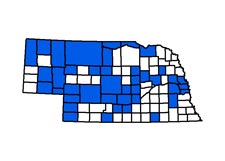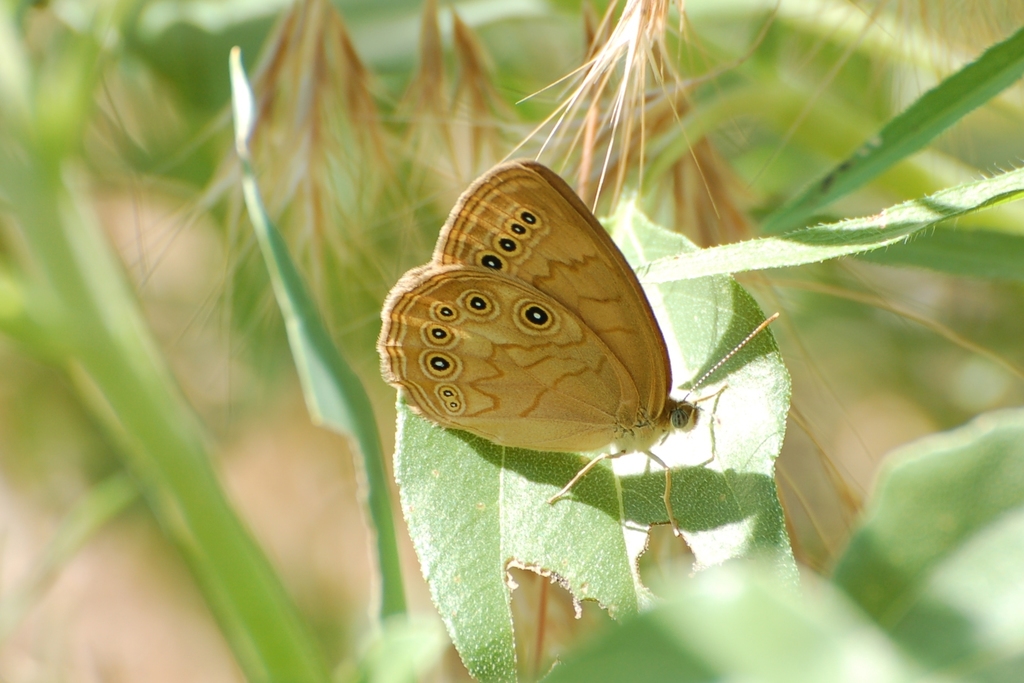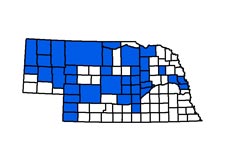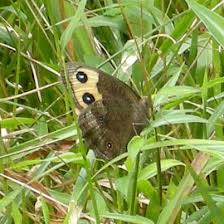I decided to make a day trip to the Victoria Springs area in Custer county to try to knock off two or three species – Acadian Hairstreaks, Silver Bordered Fritillaries and Eyed Browns and scratch my wetlands itch. So after getting a bit of a late start I arrived at the State Recreation Area about 11:00 am. After taking a quick tour I headed off to my go to Silver Bordered Fritillary spot – Alexandria Creek at the Milburn Road bridge. Once there I quickly spotted several Eyed Browns (Lethe eurydice), a Wood Nymph (Cercyonis pegala) both new, a couple of Regal Fritillaries, a Bronze Copper and Pecks and Long Dash Skippers. Additional searching yielded no Silver Bordered Fritillaries. As they are triple brooded, flying in the spring, mid and late summer I decided I must be between broods with the mid summer flight having not yet commenced. So with wet shoes I backtracked to a promising spot I’d passed by on the way up along the way up – a road along the Middle Loup River by the old town of Walworth. The road ran right next to the river for about a quarter mile and so I road hunted (again) that section and came across a milkweed in bloom next to some small willows. Thinking that looked promising I got out for a closer look and there it was – an Acadian Hairstreak (Satyrium acadica – whose larvae feed on willows). Go figure – every once in a while the world makes sense. So with a few odd jobs left undone at home and no more promising leads I headed back with three “Big Year” additions and feeling like maybe the world wasn’t totally messed up after all.
Acadian Hairstreak – from the June 19th post (It’s Hairstreak Season) “Larvae feed on willows (Salix sp.) and adults are usually found in riparian areas on or near their hostplants. Adults, which can be found from late June to mid July, are lighter colored than other members of this genus. Maculation on the interior of the ventral hindwing consist of a row of dots. They appear to be less common south of the Platte River valley but otherwise can be found statewide.”

Acadian Hairstreak – photo by Randy Floyd (iNaturalist) 
Acadian Hairstreak range in Nebraska
Eyed Brown – This butterfly can be found from late June into early July in marshes and riparian environments where larvae eat sedges. In Nebraska this species is largely absent from areas south of the Platte River, probably due to the lack of wetlands there.

Eyed Brown – photo by Cory Gregory (iNaturalist) 
range of Eyed Brown in Nebraska
Wood Nymph – Despite the name this butterfly is usually not a resident of woods although woodland margins may be utilized. One generation of this butterfly emerges in late June with tattered adults sometimes lingering well into September. While they are somewhat tolerant of disturbance native grasslands are required to support populations of Wood Nymphs with larvae feeding on Bluestems, Purpletop, Oatgrass, Needlegrasses and others. There is a clinal shift in appearance from north to south in the state. Northern populations are almost uniformly dark brown/black while individuals from our more southerly counties sometimes have extensive yellow coloration around the eyespots. Taxonomists have delighted naming all sorts of weakly differentiated (my opinion) subspecies, 19 at last count. This butterfly has been found in all 93 Nebraska counties.

Wood Nymph (subspecies olympus?) 
Wood Nymph (subspecies texana?)
With the addition of Saturday’s three species the “Big Year” total is up to 81.

Neil, I’m really enjoying your blogs! You have a great gift with this! I get excited right along with you and Jen with all you are finding! You’re seeing a lot of nice areas of Nebraska in your travels! Enjoy! I miss seeing you both!